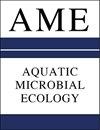营养物富集对寡营养浮游植物群落的影响:美国夏威夷附近的一个中生态试验
IF 1.1
4区 环境科学与生态学
Q3 ECOLOGY
引用次数: 0
摘要
摘要:在美国夏威夷岛外海进行了一项大规模的基于微生态系统的营养扰动实验,研究了表层海洋浮游植物群落对添加大量营养元素、微量金属和维生素的反应,并评估了在开阔海域使用微生态系统的可行性。放置了3个自由漂流的中游生态系统(~60 m³):一个中游生态系统作为对照(不添加营养物质);第二种(称为+P)用硝酸盐(N)、硅酸盐(Si)、磷酸盐(P)和微量金属+维生素混合物进行修正;第三种(称为- P)用N、Si和微量金属+维生素混合物(但不含P)进行修饰,由于后勤限制,这些中尺度没有重复,因此处理之间的差异是定性的。6 d后,浮游植物群落对+P的响应最大,叶绿素a和基于14c的初级产量比−P高2 ~ 3倍,比对照高4 ~ 6倍。对比中环境和微观环境孵育(20 l)的结果显示,硅藻在数量和生产时间上存在差异,群落结构也存在显著差异,微观环境处理降低了硅藻的反应。值得注意的是,我们还观察到在所有处理中原绿球藻种群的显著下降,尽管这些在微观环境中更大(高达99%)。总的来说,本研究证实了在开放海洋中部署自由漂流的中生态系统作为研究营养扰动对生态影响的潜在有力工具的可行性,并构成了扩大浮游生物操纵实验的有价值的第一步。本文章由计算机程序翻译,如有差异,请以英文原文为准。
Effects of nutrient enrichments on oligotrophic phytoplankton communities: a mesocosm experiment near Hawai‘i, USA
: A large-volume mesocosm-based nutrient perturbation experiment was conducted off the island of Hawai‘i, USA, to investigate the response of surface ocean phytoplankton communities to the addition of macronutrients, trace metals, and vitamins and to assess the feasibility of using mesocosms in the open ocean. Three free-drifting mesocosms (~60 m 3 ) were de ployed: one mesocosm served as a control (no nutrient amendments); a second (termed +P) was amended with nitrate (N), silicate (Si), phosphate (P), and a trace metal + vitamin mixture; and a third (termed −P) was amended with N, Si, and a trace metal + vitamin mixture but no P. These meso-cosms were unreplicated due to logistical constraints and hence differences between treatments are qualitative. After 6 d, the largest response of the phytoplankton community was ob served in the +P mesocosm, where chlorophyll a and 14 C-based primary production were 2−3× greater than in the −P mesocosm and 4−6× greater than in the control. Comparison between mesocosm and ‘microcosm’ incubations (20 l) revealed differences in the magnitude and timing of production and marked differences in community structure with a reduced response of diatoms in microcosm treatments. Notably, we also observed pronounced declines in Prochlorococcus populations in all treatments, although these were greater in microcosms (up to 99%). Overall, this study confirmed the feasibility of deploying free-drifting mesocosms in the open ocean as a potentially powerful tool to investigate ecological impacts of nutrient perturbations and constitutes a valuable first step towards scaling plankton manipulation experiments.
求助全文
通过发布文献求助,成功后即可免费获取论文全文。
去求助
来源期刊

Aquatic Microbial Ecology
环境科学-海洋与淡水生物学
CiteScore
3.30
自引率
0.00%
发文量
8
审稿时长
3.0 months
期刊介绍:
AME is international and interdisciplinary. It presents rigorously refereed and carefully selected Research Articles, Reviews and Notes, as well as Comments/Reply Comments (for details see AME 27:209), Opinion Pieces (previously called ''As I See It'') and AME Specials. For details consult the Guidelines for Authors. Papers may be concerned with:
Tolerances and responses of microorganisms to variations in abiotic and biotic components of their environment; microbial life under extreme environmental conditions (climate, temperature, pressure, osmolarity, redox, etc.).
Role of aquatic microorganisms in the production, transformation and decomposition of organic matter; flow patterns of energy and matter as these pass through microorganisms; population dynamics; trophic interrelationships; modelling, both theoretical and via computer simulation, of individual microorganisms and microbial populations; biodiversity.
Absorption and transformation of inorganic material; synthesis and transformation of organic material (autotrophic and heterotrophic); non-genetic and genetic adaptation; behaviour; molecular microbial ecology; symbioses.
 求助内容:
求助内容: 应助结果提醒方式:
应助结果提醒方式:


